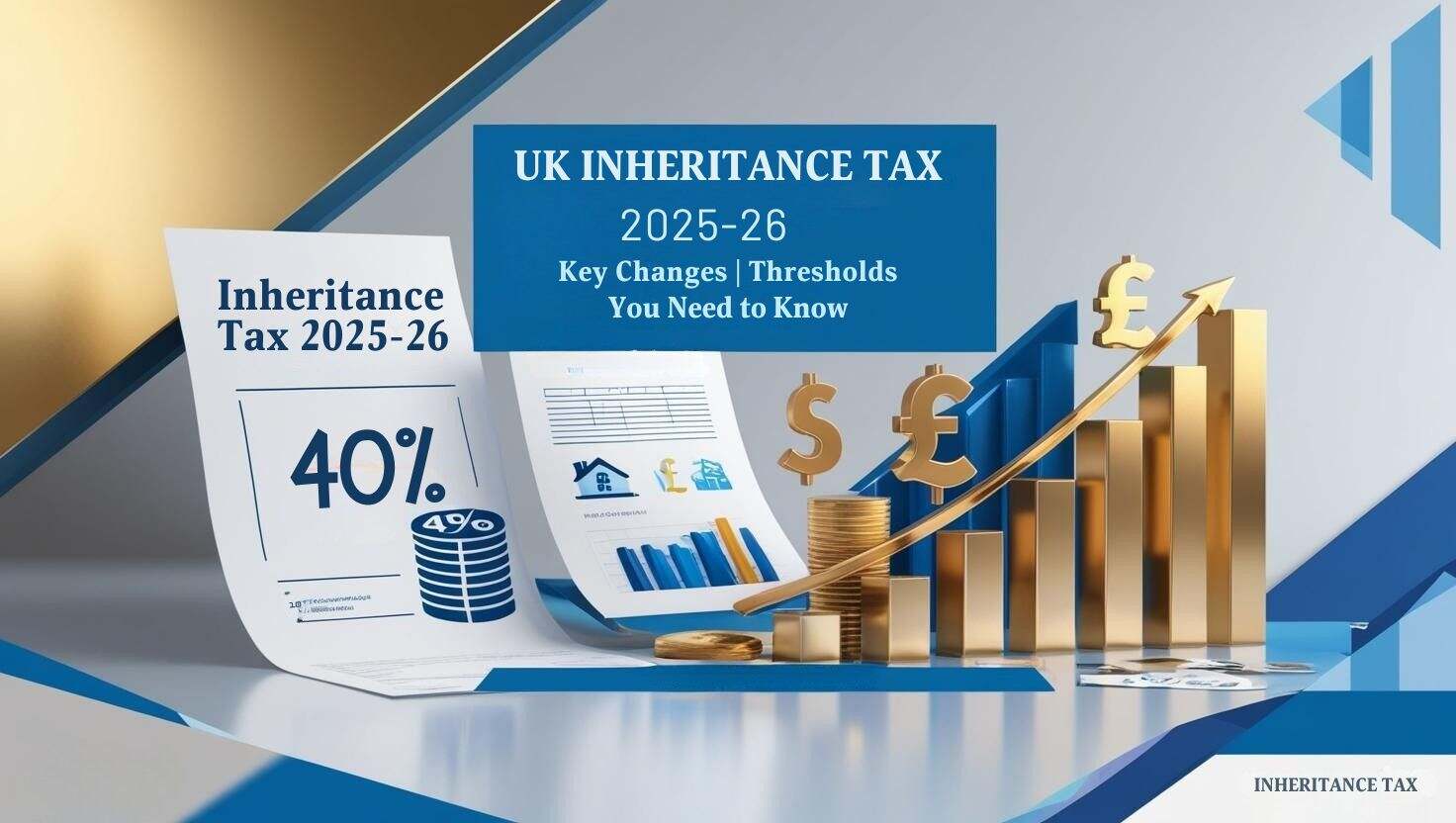Inheritance Taxation in UK

The UK inheritance tax landscape is undergoing significant changes for the 2025-26 tax year, with major reforms set to take effect from April 6, 2025. Whether you’re planning your estate or expecting an inheritance, understanding these changes is crucial for effective financial planning. This blog covers everything you need to know about UK inheritance tax for 2025-26, including the latest thresholds, rates, exemptions, and the landmark shift from domicile-based to residence-based taxation.
What is Inheritance Tax in the UK?
Inheritance Tax (IHT) is a tax levied on the estate (property, money, and possessions) of someone who has died. It’s charged at 40% on the portion of the estate that exceeds the tax-free threshold, known as the nil-rate band.
Not everyone needs to pay inheritance tax. It typically applies when the total value of an estate exceeds the tax-free threshold. HM Revenue and Customs (HMRC) is responsible for collecting inheritance tax, which must usually be paid within six months of the person’s death.
IHT is designed to redistribute wealth and generate revenue for public services. However, with proper planning, there are legitimate ways to reduce potential inheritance tax liabilities while complying with HMRC regulations.
UK Inheritance Tax Thresholds and Rates (2025-26)
Inheritance Tax Threshold (Nil-Rate Band)
For the 2025-26 tax year, the standard inheritance tax threshold (nil-rate band) remains frozen at £325,000 per person. This threshold will stay at this level until at least April 2028, as confirmed in previous government announcements.
This means that if your estate is valued below £325,000, no inheritance tax will be payable. For estates valued above this threshold, the 40% tax rate applies to the excess. Understanding tax thresholds is crucial for effective planning. Similarly, knowing how UK Income Tax works can help manage your overall financial strategy.
Read- UK Income Tax 2025-26: What to Know Before April 2025!
Residence Nil-Rate Band (RNRB)
In addition to the standard nil-rate band, there’s an extra allowance called the Residence Nil-Rate Band (RNRB). This applies when you leave your home to direct descendants (children, grandchildren, etc.).
For 2025-26, the RNRB remains at £175,000 per person. This means that individuals can potentially pass on up to £500,000 (£325,000 + £175,000) tax-free, and married couples or civil partners can potentially pass on up to £1 million combined (assuming full use of both partners’ allowances).
However, the RNRB starts to taper down if your estate is worth more than £2 million, reducing by £1 for every £2 that the estate exceeds this threshold.
Inheritance Tax Rates (2025-26)
The standard inheritance tax rate for 2025-26 remains at 40% for estates above the applicable threshold. However, if you leave at least 10% of your net estate to charity, the rate may be reduced to 36%.
It’s important to note that inheritance tax is only charged on the portion of the estate that exceeds the threshold, not the entire estate value.
Inheritance Tax Exemptions and Reliefs
Several exemptions and reliefs can reduce or eliminate inheritance tax liability:
Spouse or Civil Partner Exemption
Assets passed between spouses or civil partners are exempt from inheritance tax, regardless of their value. This exemption applies whether assets are transferred during lifetime or upon death.
Charitable Donations
Gifts to qualifying charities are exempt from inheritance tax. Additionally, as mentioned earlier, leaving at least 10% of your net estate to charity can reduce the inheritance tax rate from 40% to 36% on the remainder.
Agricultural Property Relief (APR)
Agricultural Property Relief (APR) provides relief from inheritance tax for agricultural property. Historically, APR offered 100% relief on qualifying agricultural property with no upper limit.
However, following Rachel Reeves’ first Budget in October 2024, changes have been made to APR. While the specific details of these changes weren’t fully provided in the search results, it was mentioned that these modifications were among the most controversial changes in the Budget.
Business Property Relief (BPR)
Similar to APR, Business Property Relief (BPR) provides relief from inheritance tax for business assets. The rate of relief is either 50% or 100%, depending on the type of asset.
Armed Forces Exemption
Inheritance tax is not charged on the estates of armed forces personnel who die in service or as a result of injuries sustained while in service.
Lifetime Gifts and Inheritance Tax Implications
Making gifts during your lifetime can be an effective way to reduce potential inheritance tax liability:
Potentially Exempt Transfers (PETs)
Gifts made to individuals during your lifetime are known as Potentially Exempt Transfers (PETs). These gifts become completely exempt from inheritance tax if you survive for seven years after making them.
The Seven-Year Rule (Taper Relief)
If you die within seven years of making a gift, it may be subject to inheritance tax. However, the tax due reduces on a sliding scale (known as taper relief) if the gift was made between three and seven years before death:
- Within 3 years: 40% tax (full rate)
- 3-4 years: 32% tax
- 4-5 years: 24% tax
- 5-6 years: 16% tax
- 6-7 years: 8% tax
- After 7 years: 0% tax
Annual Gift Allowance
You can give away up to £3,000 worth of gifts each tax year without them being added to the value of your estate. This is known as your annual exemption.
Small Gifts Exemption
You can give as many gifts of up to £250 per person as you want during the tax year, as long as you haven’t used another exemption on the same person.
Wedding and Civil Partnership Gifts
Special exemptions apply to wedding or civil partnership gifts, depending on your relationship to the couple:
- Parents can give up to £5,000
- Grandparents and great-grandparents can give up to £2,500
- Anyone else can give up to £1,000
Understanding Probate and Its Relationship with Inheritance Tax
Probate is the legal process of administering a deceased person’s estate. It involves gathering the deceased’s assets, paying any liabilities, and distributing what remains to beneficiaries.
Inheritance tax and probate are closely linked:
- Executors usually need to pay at least some inheritance tax before probate can be granted
- The probate application requires a completed inheritance tax form, even if no tax is due
- In England and Wales, the probate fee is based on the estate’s value
The process can be complex, especially for larger estates. Professional advice is often recommended to navigate both probate and inheritance tax requirements efficiently.
To apply for Probate: CLICK HERE
How to Calculate and Pay Inheritance Tax in 2025-26
Calculating inheritance tax involves several steps:
- Value the estate (property, money, possessions, investments, etc.)
- Deduct any debts and liabilities
- Subtract any exempt assets (e.g., spouse transfers, charitable gifts)
- Apply the nil-rate band and residence nil-rate band if applicable
- Calculate tax at 40% (or 36% if 10% or more goes to charity) on the remainder
Inheritance tax is typically due six months after the person’s death. HMRC charges interest on late payments, so prompt payment is advisable.
For estates that include property or business assets, inheritance tax can sometimes be paid in installments over ten years. However, interest will be charged on the outstanding amount.
Effective Inheritance Tax Planning Strategies for 2025-26
With significant changes coming in April 2025, inheritance tax planning is more important than ever. Consider these strategies:
Make Use of Lifetime Gifts
Utilizing your annual gift allowances and making potentially exempt transfers can reduce your estate’s value over time. Start early to maximize the benefit of the seven-year rule.
Consider Trusts
While trusts have become less tax-advantageous in recent years, they can still be useful in certain circumstances. From April 2025, there will be significant changes to how foreign assets held in trusts are treated for inheritance tax purposes.
Write a Will
A properly structured will ensure your assets go to the intended beneficiaries and can help minimize inheritance tax. Without a will, your estate is distributed according to intestacy rules, which might not be tax-efficient.
Consider Charitable Giving
Leaving at least 10% of your net estate to charity reduces the inheritance tax rate on the remainder from 40% to 36%. This can sometimes result in more being left to both charity and other beneficiaries.
Use Pensions for Inheritance Planning
Pensions can be an effective way to pass on wealth. In many cases, pension funds remain outside your estate for inheritance tax purposes.
Recent Changes to UK Inheritance Tax Rules for 2025-26
The 2025-26 tax year brings significant changes to UK inheritance tax rules:
Shift from Domicile to Residence-Based Taxation
From April 6, 2025, the UK will fundamentally change how it determines inheritance tax liability for non-UK assets. The system will shift from being based on domicile to being based on residence.
Under the new residence-based test, an individual’s non-UK assets will be within the scope of inheritance tax once they have been resident in the UK for 10 years. This is a major change that will affect not only those who are currently non-UK domiciled but also UK-domiciled individuals considering moving overseas.
Changes to Trust Taxation
From April 2025, all foreign assets held in a trust will become subject to inheritance tax, regardless of when the trust was settled, for anyone living in the UK permanently. This significantly changes the current IHT exposure for foreign assets held in existing excluded property trusts.
Frozen Thresholds
The inheritance tax nil-rate band (£325,000) and residence nil-rate band (£175,000) will remain frozen until at least April 2028. With rising asset values, especially property prices, more estates may become liable for inheritance tax due to these frozen thresholds.
Common Mistakes to Avoid When Handling Inheritance Tax
Avoid these common pitfalls in inheritance tax planning:
Not Keeping Accurate Gift Records
Keep detailed records of all gifts made, including dates, values, and recipients. This information is crucial for executors when calculating potential inheritance tax liabilities.
Incorrect Valuation of Assets
Ensure professional valuations for significant assets, especially property and business interests. HMRC can challenge valuations they believe are inaccurate.
Not Planning Early Enough
Inheritance tax planning works best when started early. Last-minute arrangements may be ineffective or scrutinized by HMRC.
Forgetting Insurance Options
Life insurance policies written in trust can provide funds to pay inheritance tax without increasing the estate’s value.
Ignoring Agricultural and Business Property Relief
If you own a business or agricultural property, ensure you understand the reliefs available and structure your affairs to maximize these benefits.
Helpful Resources and Tools
HMRC and other organizations provide various resources to help with inheritance tax planning:
- HMRC Inheritance Tax calculator: Helps estimate potential inheritance tax liability
- IHT400 and IHT205 forms: Required for reporting the estate’s value to HMRC
- GOV.UK inheritance tax guides: Detailed information on all aspects of inheritance tax
- Probate application online portal: Simplifies the probate application process
Professional advice from solicitors, accountants, or financial advisors specializing in inheritance tax can be invaluable, especially with the significant changes coming in April 2025.
Takeaways
The 2025-26 tax year brings significant changes to UK inheritance tax rules, particularly the shift from domicile-based to residence-based taxation for non-UK assets. Understanding these changes and planning accordingly is essential for effective estate planning.
Key points to remember:
- The nil-rate band (£325,000) and residence nil-rate band (£175,000) remain frozen until at least April 2028
- From April 6, 2025, inheritance tax liability for non-UK assets will be determined by residence rather than domicile
- Early and regular inheritance tax planning can significantly reduce potential liabilities
- Professional advice is often worthwhile, especially for larger or more complex estates
Inheritance tax planning should be an integral part of your overall financial strategy. With significant changes coming in April 2025, now is the perfect time to review your arrangements:
- Consider consulting with a qualified financial advisor or tax specialist who can provide personalized guidance
- Review your will to ensure it reflects current legislation and your wishes
- Start planning early to maximize the benefits of lifetime gifting and other tax-efficient strategies
- Stay informed about further changes to inheritance tax rules that may affect your planning
For the latest updates on UK inheritance tax and other financial matters, subscribe to our newsletter and join our community of informed investors planning for their financial futures.
Frequently Asked Questions (FAQs)
1. Who is responsible for paying inheritance tax?
Typically, the executor of the will or administrator of the estate is responsible for paying inheritance tax from the estate’s funds.
2. How much money can you inherit before paying tax in 2025-26?
The standard inheritance tax threshold remains at £325,000 per person, with an additional residence nil-rate band of up to £175,000 when leaving a home to direct descendants. Married couples and civil partners can combine their allowances, potentially allowing up to £1 million to be passed on tax-free.
3. Do spouses have to pay inheritance tax?
No, transfers between spouses or civil partners are exempt from inheritance tax, regardless of the amount.
4. What assets are exempt from inheritance tax?
Assets that may be exempt include those transferred to spouses/civil partners, qualifying charitable donations, certain business and agricultural property, and some heritage assets.
5. How will the 2025 changes affect non-UK domiciled individuals?
From April 6, 2025, non-UK assets will be subject to UK inheritance tax based on residence rather than domicile. After 10 years of UK residence, non-UK assets will be within the scope of UK inheritance tax.
Source / Ref.: Gov.uk Contains public sector information licensed under Open Government Licence v3.0.
Written by [Ketan Borada / British Portal Team] – Founder of British Portal, dedicated to providing accurate and up-to-date information on UK public services and benefits.






















